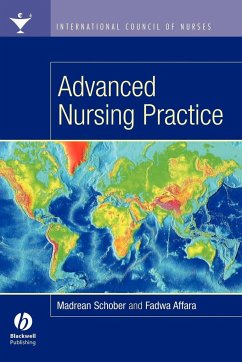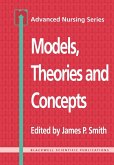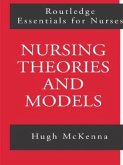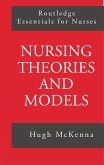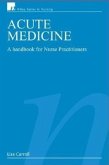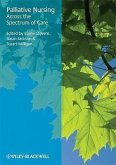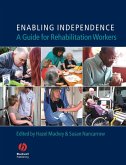- Broschiertes Buch
- Merkliste
- Auf die Merkliste
- Bewerten Bewerten
- Teilen
- Produkt teilen
- Produkterinnerung
- Produkterinnerung
Advanced Nursing Practice addresses the key issues in practice, education, regulation, research and role/practice development, which are central to defining the distinctive nature of advanced nursing practice (ANP) and explores international developments in the field of ANP. Advanced Nursing Practice has been developed in recognition of the key role nurses with advanced knowledge and skills play in developing health care services worldwide. The book tracks the evolution of new advanced practice nursing roles and innovative practice models, and examines the need for international guidelines. In…mehr
Andere Kunden interessierten sich auch für
![Models, Theories and Concepts Models, Theories and Concepts]() Models, Theories and Concepts71,99 €
Models, Theories and Concepts71,99 €![Nursing Theories and Models Nursing Theories and Models]() Hugh MckennaNursing Theories and Models81,99 €
Hugh MckennaNursing Theories and Models81,99 €![Nursing Theories and Models Nursing Theories and Models]() Hugh MckennaNursing Theories and Models202,99 €
Hugh MckennaNursing Theories and Models202,99 €![Acute Medicine Acute Medicine]() Lisa CarrollAcute Medicine92,99 €
Lisa CarrollAcute Medicine92,99 €![Palliative Nursing Palliative Nursing]() Palliative Nursing77,99 €
Palliative Nursing77,99 €![Engaging Reflection in Practice Engaging Reflection in Practice]() Christopher JohnsEngaging Reflection in Practice81,99 €
Christopher JohnsEngaging Reflection in Practice81,99 €![Enabling Independence Enabling Independence]() Hazel Mackey / Jimi Cook / Susan Nancarrow / John InnesEnabling Independence66,99 €
Hazel Mackey / Jimi Cook / Susan Nancarrow / John InnesEnabling Independence66,99 €-
-
-
Advanced Nursing Practice addresses the key issues in practice, education, regulation, research and role/practice development, which are central to defining the distinctive nature of advanced nursing practice (ANP) and explores international developments in the field of ANP. Advanced Nursing Practice has been developed in recognition of the key role nurses with advanced knowledge and skills play in developing health care services worldwide. The book tracks the evolution of new advanced practice nursing roles and innovative practice models, and examines the need for international guidelines. In exploring strategies for implementing ANP in the context of countries' health care needs, Advanced Nursing Practice addresses legal and ethical challenges and commonalities and differences in advanced nursing practice, while examining the implications, obstacles, and facilitative strategies in maintaining, implementing and supporting the development of ANP. This book provides guidance in decision-making, examines the implications for liaising with other health care professionals and encourages nurses to shape their role to the needs of their patients and practice.
Hinweis: Dieser Artikel kann nur an eine deutsche Lieferadresse ausgeliefert werden.
Hinweis: Dieser Artikel kann nur an eine deutsche Lieferadresse ausgeliefert werden.
Produktdetails
- Produktdetails
- Verlag: Wiley
- Seitenzahl: 256
- Erscheinungstermin: 28. November 2006
- Englisch
- Abmessung: 234mm x 156mm x 14mm
- Gewicht: 383g
- ISBN-13: 9781405125338
- ISBN-10: 1405125330
- Artikelnr.: 21636668
- Herstellerkennzeichnung
- Libri GmbH
- Europaallee 1
- 36244 Bad Hersfeld
- 06621 890
- Verlag: Wiley
- Seitenzahl: 256
- Erscheinungstermin: 28. November 2006
- Englisch
- Abmessung: 234mm x 156mm x 14mm
- Gewicht: 383g
- ISBN-13: 9781405125338
- ISBN-10: 1405125330
- Artikelnr.: 21636668
- Herstellerkennzeichnung
- Libri GmbH
- Europaallee 1
- 36244 Bad Hersfeld
- 06621 890
Madrean Schoberis an International Healthcare Consultant; past-Chair of the ICN International Nurse Practitioner/Advanced Practice Nursing Network; and International Relations Liaison for the American Academy of Nurse Practitioners. Fadwa A. Affara is Nurse Consultant, Education and Regulation Policy undertaking consultancy work for ICN, WHO and other agencies, particularly in the field of regulation. She helped set up the Regulation Network and International Nurse Practitioner/Advanced Practice Nursing Network while at the ICN.
Contents
Foreword ix
Preface xi
Acknowledgements xv
1 Introduction 1
Advanced nursing practice: a growing presence 1
Advanced nursing practice: patterns of development 2
Advanced nursing practice: a global picture 10
Definition of the advanced practice nurse 11
Conclusion 13
References 13
2 Nature of practice 17
Introduction 17
Advanced practice nurse (APN) characteristics 22
ICN official position on APN characteristics 22
Country illustrations 23
Labelling the role 24
Titling 24
Title protection 26
Scope of practice 26
What is scope of practice? 26
What influences scope of practice? 28
Points to consider when defining scope of practice 29
Core competencies 30
Competency: the basis for education and practice 32
Creating a competency map 33
Formulating competency statements 34
Advanced tasks versus advanced roles 35
Controversial practice topics 36
Prescriptive authority 36
The diagnosis debate 39
Hospital privileges 41
Domains of practice 42
Practice settings 45
Conclusion 45
References 45
3 Role and practice development 50
Introduction 50
Striving for the ideal: transitional processes 51
Assessing the opportunity and need for advanced nursing practice 52
Scanning the environment 52
Introducing and supporting advanced nursing practice 56
Interfacing with nurses, physicians, organisations and the public 60
Interface with nursing 60
Interface with medicine 65
Interface with organisational structures 68
Interface with the public 69
Socialisation: role support 71
Strategies to support new APNs 73
Ethical dimensions of the advanced nursing practice role 74
Conclusion 77
References 78
4 Regulation 81
Introduction 81
The regulatory/legislative framework 82
Factors influencing the regulatory/legislative systems 84
Credentialing advanced nursing practice 84
Components of the credentialing framework 86
The credentialee 86
Credentialing mechanisms 88
Credentialer 96
Purpose 96
Powers 97
Standards 97
Processes 98
Term or duration 98
Costs 99
Effectiveness 101
Mutual recognition agreements 101
Model for a regulatory system for advanced nursing practice 102
Exploring your regulatory environment 104
Preparation 104
Forming an overview of the regulatory/legislative systems 104
Understanding regulatory and legal frameworks for advanced nursing practice
105
Advocating for regulatory/legislative change 106
Document analysis 107
Advocacy strategies 107
Conclusion 109
References 109
5 Education for advanced nursing practice 112
Introduction 112
Characteristics of advanced nursing practice education 113
The case for master's level education 114
Debate around master's level education 114
Country variation in education philosophy, approach and development 115
Paths of entry into programmes and length of study 118
Vignettes of advanced nursing practice educational development 118
Assessment of prior experience and bridging mechanisms 120
Curriculum development 121
A curriculum framework to promote flexibility 122
Curriculum: course distribution 124
Advanced practice clinical experience 125
Settings for clinical experience 126
Preceptors and quality of clinical placements 127
Planning for the precepting experience 128
Examples of APN student practicum in new settings 128
Faculty background and preparation 130
Professional development and continuing education 132
Educational standards and programme accreditation 133
Conclusion 133
References 134
6 Research 137
Theoretical perspective of advanced nursing practice 137
Exploring the research perspective 139
Promoting diverse and analytical research 140
Research for advocacy 140
Enhancing knowledge and skills in research 141
The research culture 142
Research competence 142
Writing for publication 143
Searching for research funding 146
International Classification for Nursing Practice® (ICNP): A tool for
collaborative nursing research 147
An international research agenda for advanced nursing practice 149
Conclusion 152
References 152
7 Future prospects and critical challenges for advanced nursing practice
154
Introduction 154
Future prospects 155
Preparing a health care workforce for the 21st century 155
Primary health care services 155
Chronic conditions and home care 156
Technology and telehealth 157
Nurse entrepreneurs 158
Critical challenges 158
Critical challenge 1: integrating advanced practice nurses into workforce
planning 159
Critical challenge 2: international consensus-building around definitions,
scope of practice, core competencies and education 161
Critical challenge 3: capacity building to strengthen advanced nursing
practice in health systems internationally 162
Critical challenge 4: defining the gaps and finding the evidence 164
Conclusion 165
References 166
Appendix 1 Key Informant Survey on Advanced Nursing Practice (ANP)
Self-Administered Questionnaire 167
Appendix 2 Scope of practice examples 173
Appendix 3 Strengths, Weaknesses, Opportunities, Threats (SWOT) 177
Appendix 4 Principles to guide standards development 178
Appendix 5 Samples of course descriptions in an advanced nursing practice
curriculum 181
Appendix 6 Preceptor guidelines, student and preceptor evaluation form 189
Appendix 7 Checklist for authors preparing to submit an article for
publication 192
Appendix 8 Example of statements in an ICNP® catalogue on adherence to
treatment 194
Resources 196
Bibliography from key informants 204
Glossary 210
Index 219
Foreword ix
Preface xi
Acknowledgements xv
1 Introduction 1
Advanced nursing practice: a growing presence 1
Advanced nursing practice: patterns of development 2
Advanced nursing practice: a global picture 10
Definition of the advanced practice nurse 11
Conclusion 13
References 13
2 Nature of practice 17
Introduction 17
Advanced practice nurse (APN) characteristics 22
ICN official position on APN characteristics 22
Country illustrations 23
Labelling the role 24
Titling 24
Title protection 26
Scope of practice 26
What is scope of practice? 26
What influences scope of practice? 28
Points to consider when defining scope of practice 29
Core competencies 30
Competency: the basis for education and practice 32
Creating a competency map 33
Formulating competency statements 34
Advanced tasks versus advanced roles 35
Controversial practice topics 36
Prescriptive authority 36
The diagnosis debate 39
Hospital privileges 41
Domains of practice 42
Practice settings 45
Conclusion 45
References 45
3 Role and practice development 50
Introduction 50
Striving for the ideal: transitional processes 51
Assessing the opportunity and need for advanced nursing practice 52
Scanning the environment 52
Introducing and supporting advanced nursing practice 56
Interfacing with nurses, physicians, organisations and the public 60
Interface with nursing 60
Interface with medicine 65
Interface with organisational structures 68
Interface with the public 69
Socialisation: role support 71
Strategies to support new APNs 73
Ethical dimensions of the advanced nursing practice role 74
Conclusion 77
References 78
4 Regulation 81
Introduction 81
The regulatory/legislative framework 82
Factors influencing the regulatory/legislative systems 84
Credentialing advanced nursing practice 84
Components of the credentialing framework 86
The credentialee 86
Credentialing mechanisms 88
Credentialer 96
Purpose 96
Powers 97
Standards 97
Processes 98
Term or duration 98
Costs 99
Effectiveness 101
Mutual recognition agreements 101
Model for a regulatory system for advanced nursing practice 102
Exploring your regulatory environment 104
Preparation 104
Forming an overview of the regulatory/legislative systems 104
Understanding regulatory and legal frameworks for advanced nursing practice
105
Advocating for regulatory/legislative change 106
Document analysis 107
Advocacy strategies 107
Conclusion 109
References 109
5 Education for advanced nursing practice 112
Introduction 112
Characteristics of advanced nursing practice education 113
The case for master's level education 114
Debate around master's level education 114
Country variation in education philosophy, approach and development 115
Paths of entry into programmes and length of study 118
Vignettes of advanced nursing practice educational development 118
Assessment of prior experience and bridging mechanisms 120
Curriculum development 121
A curriculum framework to promote flexibility 122
Curriculum: course distribution 124
Advanced practice clinical experience 125
Settings for clinical experience 126
Preceptors and quality of clinical placements 127
Planning for the precepting experience 128
Examples of APN student practicum in new settings 128
Faculty background and preparation 130
Professional development and continuing education 132
Educational standards and programme accreditation 133
Conclusion 133
References 134
6 Research 137
Theoretical perspective of advanced nursing practice 137
Exploring the research perspective 139
Promoting diverse and analytical research 140
Research for advocacy 140
Enhancing knowledge and skills in research 141
The research culture 142
Research competence 142
Writing for publication 143
Searching for research funding 146
International Classification for Nursing Practice® (ICNP): A tool for
collaborative nursing research 147
An international research agenda for advanced nursing practice 149
Conclusion 152
References 152
7 Future prospects and critical challenges for advanced nursing practice
154
Introduction 154
Future prospects 155
Preparing a health care workforce for the 21st century 155
Primary health care services 155
Chronic conditions and home care 156
Technology and telehealth 157
Nurse entrepreneurs 158
Critical challenges 158
Critical challenge 1: integrating advanced practice nurses into workforce
planning 159
Critical challenge 2: international consensus-building around definitions,
scope of practice, core competencies and education 161
Critical challenge 3: capacity building to strengthen advanced nursing
practice in health systems internationally 162
Critical challenge 4: defining the gaps and finding the evidence 164
Conclusion 165
References 166
Appendix 1 Key Informant Survey on Advanced Nursing Practice (ANP)
Self-Administered Questionnaire 167
Appendix 2 Scope of practice examples 173
Appendix 3 Strengths, Weaknesses, Opportunities, Threats (SWOT) 177
Appendix 4 Principles to guide standards development 178
Appendix 5 Samples of course descriptions in an advanced nursing practice
curriculum 181
Appendix 6 Preceptor guidelines, student and preceptor evaluation form 189
Appendix 7 Checklist for authors preparing to submit an article for
publication 192
Appendix 8 Example of statements in an ICNP® catalogue on adherence to
treatment 194
Resources 196
Bibliography from key informants 204
Glossary 210
Index 219
Contents
Foreword ix
Preface xi
Acknowledgements xv
1 Introduction 1
Advanced nursing practice: a growing presence 1
Advanced nursing practice: patterns of development 2
Advanced nursing practice: a global picture 10
Definition of the advanced practice nurse 11
Conclusion 13
References 13
2 Nature of practice 17
Introduction 17
Advanced practice nurse (APN) characteristics 22
ICN official position on APN characteristics 22
Country illustrations 23
Labelling the role 24
Titling 24
Title protection 26
Scope of practice 26
What is scope of practice? 26
What influences scope of practice? 28
Points to consider when defining scope of practice 29
Core competencies 30
Competency: the basis for education and practice 32
Creating a competency map 33
Formulating competency statements 34
Advanced tasks versus advanced roles 35
Controversial practice topics 36
Prescriptive authority 36
The diagnosis debate 39
Hospital privileges 41
Domains of practice 42
Practice settings 45
Conclusion 45
References 45
3 Role and practice development 50
Introduction 50
Striving for the ideal: transitional processes 51
Assessing the opportunity and need for advanced nursing practice 52
Scanning the environment 52
Introducing and supporting advanced nursing practice 56
Interfacing with nurses, physicians, organisations and the public 60
Interface with nursing 60
Interface with medicine 65
Interface with organisational structures 68
Interface with the public 69
Socialisation: role support 71
Strategies to support new APNs 73
Ethical dimensions of the advanced nursing practice role 74
Conclusion 77
References 78
4 Regulation 81
Introduction 81
The regulatory/legislative framework 82
Factors influencing the regulatory/legislative systems 84
Credentialing advanced nursing practice 84
Components of the credentialing framework 86
The credentialee 86
Credentialing mechanisms 88
Credentialer 96
Purpose 96
Powers 97
Standards 97
Processes 98
Term or duration 98
Costs 99
Effectiveness 101
Mutual recognition agreements 101
Model for a regulatory system for advanced nursing practice 102
Exploring your regulatory environment 104
Preparation 104
Forming an overview of the regulatory/legislative systems 104
Understanding regulatory and legal frameworks for advanced nursing practice
105
Advocating for regulatory/legislative change 106
Document analysis 107
Advocacy strategies 107
Conclusion 109
References 109
5 Education for advanced nursing practice 112
Introduction 112
Characteristics of advanced nursing practice education 113
The case for master's level education 114
Debate around master's level education 114
Country variation in education philosophy, approach and development 115
Paths of entry into programmes and length of study 118
Vignettes of advanced nursing practice educational development 118
Assessment of prior experience and bridging mechanisms 120
Curriculum development 121
A curriculum framework to promote flexibility 122
Curriculum: course distribution 124
Advanced practice clinical experience 125
Settings for clinical experience 126
Preceptors and quality of clinical placements 127
Planning for the precepting experience 128
Examples of APN student practicum in new settings 128
Faculty background and preparation 130
Professional development and continuing education 132
Educational standards and programme accreditation 133
Conclusion 133
References 134
6 Research 137
Theoretical perspective of advanced nursing practice 137
Exploring the research perspective 139
Promoting diverse and analytical research 140
Research for advocacy 140
Enhancing knowledge and skills in research 141
The research culture 142
Research competence 142
Writing for publication 143
Searching for research funding 146
International Classification for Nursing Practice® (ICNP): A tool for
collaborative nursing research 147
An international research agenda for advanced nursing practice 149
Conclusion 152
References 152
7 Future prospects and critical challenges for advanced nursing practice
154
Introduction 154
Future prospects 155
Preparing a health care workforce for the 21st century 155
Primary health care services 155
Chronic conditions and home care 156
Technology and telehealth 157
Nurse entrepreneurs 158
Critical challenges 158
Critical challenge 1: integrating advanced practice nurses into workforce
planning 159
Critical challenge 2: international consensus-building around definitions,
scope of practice, core competencies and education 161
Critical challenge 3: capacity building to strengthen advanced nursing
practice in health systems internationally 162
Critical challenge 4: defining the gaps and finding the evidence 164
Conclusion 165
References 166
Appendix 1 Key Informant Survey on Advanced Nursing Practice (ANP)
Self-Administered Questionnaire 167
Appendix 2 Scope of practice examples 173
Appendix 3 Strengths, Weaknesses, Opportunities, Threats (SWOT) 177
Appendix 4 Principles to guide standards development 178
Appendix 5 Samples of course descriptions in an advanced nursing practice
curriculum 181
Appendix 6 Preceptor guidelines, student and preceptor evaluation form 189
Appendix 7 Checklist for authors preparing to submit an article for
publication 192
Appendix 8 Example of statements in an ICNP® catalogue on adherence to
treatment 194
Resources 196
Bibliography from key informants 204
Glossary 210
Index 219
Foreword ix
Preface xi
Acknowledgements xv
1 Introduction 1
Advanced nursing practice: a growing presence 1
Advanced nursing practice: patterns of development 2
Advanced nursing practice: a global picture 10
Definition of the advanced practice nurse 11
Conclusion 13
References 13
2 Nature of practice 17
Introduction 17
Advanced practice nurse (APN) characteristics 22
ICN official position on APN characteristics 22
Country illustrations 23
Labelling the role 24
Titling 24
Title protection 26
Scope of practice 26
What is scope of practice? 26
What influences scope of practice? 28
Points to consider when defining scope of practice 29
Core competencies 30
Competency: the basis for education and practice 32
Creating a competency map 33
Formulating competency statements 34
Advanced tasks versus advanced roles 35
Controversial practice topics 36
Prescriptive authority 36
The diagnosis debate 39
Hospital privileges 41
Domains of practice 42
Practice settings 45
Conclusion 45
References 45
3 Role and practice development 50
Introduction 50
Striving for the ideal: transitional processes 51
Assessing the opportunity and need for advanced nursing practice 52
Scanning the environment 52
Introducing and supporting advanced nursing practice 56
Interfacing with nurses, physicians, organisations and the public 60
Interface with nursing 60
Interface with medicine 65
Interface with organisational structures 68
Interface with the public 69
Socialisation: role support 71
Strategies to support new APNs 73
Ethical dimensions of the advanced nursing practice role 74
Conclusion 77
References 78
4 Regulation 81
Introduction 81
The regulatory/legislative framework 82
Factors influencing the regulatory/legislative systems 84
Credentialing advanced nursing practice 84
Components of the credentialing framework 86
The credentialee 86
Credentialing mechanisms 88
Credentialer 96
Purpose 96
Powers 97
Standards 97
Processes 98
Term or duration 98
Costs 99
Effectiveness 101
Mutual recognition agreements 101
Model for a regulatory system for advanced nursing practice 102
Exploring your regulatory environment 104
Preparation 104
Forming an overview of the regulatory/legislative systems 104
Understanding regulatory and legal frameworks for advanced nursing practice
105
Advocating for regulatory/legislative change 106
Document analysis 107
Advocacy strategies 107
Conclusion 109
References 109
5 Education for advanced nursing practice 112
Introduction 112
Characteristics of advanced nursing practice education 113
The case for master's level education 114
Debate around master's level education 114
Country variation in education philosophy, approach and development 115
Paths of entry into programmes and length of study 118
Vignettes of advanced nursing practice educational development 118
Assessment of prior experience and bridging mechanisms 120
Curriculum development 121
A curriculum framework to promote flexibility 122
Curriculum: course distribution 124
Advanced practice clinical experience 125
Settings for clinical experience 126
Preceptors and quality of clinical placements 127
Planning for the precepting experience 128
Examples of APN student practicum in new settings 128
Faculty background and preparation 130
Professional development and continuing education 132
Educational standards and programme accreditation 133
Conclusion 133
References 134
6 Research 137
Theoretical perspective of advanced nursing practice 137
Exploring the research perspective 139
Promoting diverse and analytical research 140
Research for advocacy 140
Enhancing knowledge and skills in research 141
The research culture 142
Research competence 142
Writing for publication 143
Searching for research funding 146
International Classification for Nursing Practice® (ICNP): A tool for
collaborative nursing research 147
An international research agenda for advanced nursing practice 149
Conclusion 152
References 152
7 Future prospects and critical challenges for advanced nursing practice
154
Introduction 154
Future prospects 155
Preparing a health care workforce for the 21st century 155
Primary health care services 155
Chronic conditions and home care 156
Technology and telehealth 157
Nurse entrepreneurs 158
Critical challenges 158
Critical challenge 1: integrating advanced practice nurses into workforce
planning 159
Critical challenge 2: international consensus-building around definitions,
scope of practice, core competencies and education 161
Critical challenge 3: capacity building to strengthen advanced nursing
practice in health systems internationally 162
Critical challenge 4: defining the gaps and finding the evidence 164
Conclusion 165
References 166
Appendix 1 Key Informant Survey on Advanced Nursing Practice (ANP)
Self-Administered Questionnaire 167
Appendix 2 Scope of practice examples 173
Appendix 3 Strengths, Weaknesses, Opportunities, Threats (SWOT) 177
Appendix 4 Principles to guide standards development 178
Appendix 5 Samples of course descriptions in an advanced nursing practice
curriculum 181
Appendix 6 Preceptor guidelines, student and preceptor evaluation form 189
Appendix 7 Checklist for authors preparing to submit an article for
publication 192
Appendix 8 Example of statements in an ICNP® catalogue on adherence to
treatment 194
Resources 196
Bibliography from key informants 204
Glossary 210
Index 219

